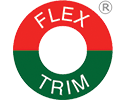
MDF
Sanding of kitchen doors
Solutions from Flex Trim have improved the edge quality and optimized the working process for one of Denmark’s leading kitchen manufacturers. The result is a high-quality MDF end product.
The customer
Flex Trim has developed solutions for leading companies in markets all over the world. In Denmark one of Flex Trim’s customers is a big and well-known kitchen manufacturer, which sells its products in Scandinavia and a number of other European markets. The company has created a very strong brand within the kitchen sector. A high and uniform quality is of decisive importance and is characteristic of the company and brand.
The task
The customer had great difficulty achieving a satisfactory edge finish on their kitchen doors. The doors are MDF and the board quality varies significantly. Despite spending a considerable amount of labour – and cost –in finishing the edges manually, the lacquer department could still not obtain the desired quality.
The solution from Flex Trim
WOOD DEPARTMENT
Edge sanding:
Flex Trim, were invited to investigate the finishing problems in the lacquer department, but soon found they needed to take a step backwards and investigate the entire manufacturing process concerning edge machining and sanding.
The solution found was to change the edge sanding from a manual process, to automatically wood-sanding in-line, immediately after the edges are profiled.
Flex Trim installed an edge sanding machine with its special sanding heads, disc sanders, with short 20 mm brushes and a grit size of 240. The customer recognized the surface was improved immediately, and when the AC (acid hardened) lacquer was applied, the finishing department soon found they only required half the lacquer they used before, and achieved an excellent result every time too.
After the implementation of the new solution from Flex Trim, the customer reduced their lacquer consumption by half!
LACQUER DEPARTMENT
Intermediate sanding:
The automatic wood-sanding process simultaneously resulted in a less demanding intermediate sanding (denibbing) of the edges. After lacquering the edges the doors go on to the intermediate sanding. For this process the customer has continued the use of its 2-handed motorcycle, which was already a part of the earlier process.
This machine employs a standard Flex Trim sanding head with grit size 220 on a 45 mm brush. After the intermediate sanding the doors go directly on to the process for top lacquer.
Surface sanding:
The new solution from Flex Trim has reduced the number of the edge treatments down to one, and the doors can go directly on to the treatment of the surfaces. For the intermediate sanding of the foiled surfaces, a 3-roller Venjakob brush sanding machine is used with a brush height of 55 mm and grit size 320. After this the lacquer is put on the edges and surfaces.
Benefits for the customer
Improved end result:
With the new solution from Flex Trim and reorganized process, the customer first of all now achieves an excellent end result and a uniformed quality of the edges on the doors.
Increased efficiency:
With the automatic sanding process, the previously necessary aftercare and repeatedly wood- and intermediate sanding are saved. In that way the efficiency has increased substantially with a reduction in manpower and a halving in turnaround time.
At the same time physical demanding work has been reduced.
Improved environment:
The consumption of lacquer has been highly reduced, which have resulted in important financial savings and also a more environmentally friendly working place and production.
